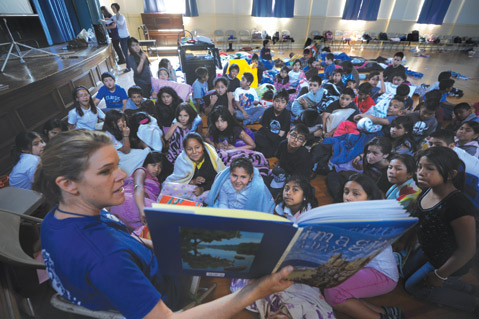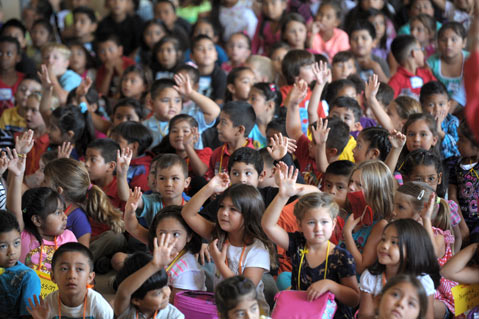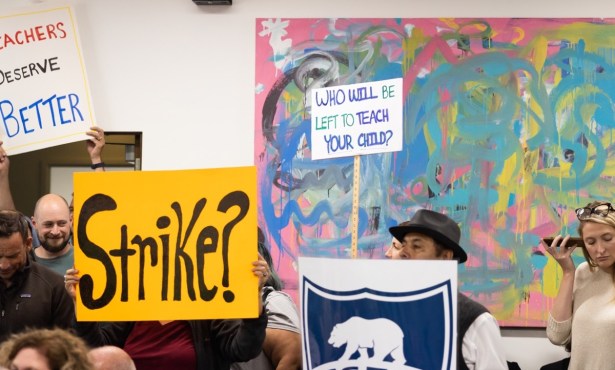Elementary School Options
Grade School Opportunities Abound in S.B.

Last Saturday on the campus of the Montessori Center School, Shaunah Berg was grilling the Brown Door teacher about a sentence-mapping activity, making sure it was rigorous enough for her son who, in another school, would be a 3rd grader. (In Montessori schools, students stay in the same color-coded classroom for three years; Brown Door refers to the classroom for grades 4-6.) Berg was taking part in the annual ritual where first-year Montessori parents follow “The Journey” of a student from preschool to their final year of the elementary grades.
As parents filed through classrooms crammed with tactile workstations and floors covered with diagrams of the equinoxes and phases of the moon — a central tenet of Montessori is that students move from concrete knowledge to abstract concepts — they asked about how teachers address different learning styles, and whether students have difficulty transitioning to junior high school. Many of the parents present were educated, professional, and extremely reflective about their children’s educations.
Santa Barbara School Board Trustee Kate Parker fits into that demographic. When it came time to choose a school for her kids, she considered independent schools. A librarian at Cate School, she even works at one. But when she visited her neighborhood school, Adams Elementary, she said, “It was like, why would I choose any place else?” Aware that independent schools tend to offer smaller class sizes that allow teachers to give more attention to their students’ writing in particular, Parker still felt Adams was the best fit and that the kindergarten looked “just as good or better” as what she saw elsewhere. It now even boasts a Montessori classroom, which Parker’s daughter attends.
Sending a child off to elementary school can be a daunting task. The formative years of an education could set a young person on a path to future academic success, a good college, and professional fulfillment. It’s where most children learn to read and write, add and subtract, but also to socialize, to focus on a task, to play well with others, to be responsible citizens. Unlike Vegas, what happens in elementary school does not stay in elementary school.
For parents with means in Santa Barbara, public schools and private schools are not really seen as competitors but parallel options. This is evident by the fact that many students will attend independent schools at one level and public schools at another. (It’s no secret, however, that parents from tonier enclaves with their own elementary school districts often send their kids to private middle schools before stashing them in one of the public high school academies.) For instance, Berg — who, despite her tough questions, is extremely pleased with Montessori Center School — also sings the praises of the preschool at the public Harding University Partnership School on the Westside.
As Alex Corman, a satisfied parent of two Crane Country Day School students, put it, “The most important advice I have is, your child is unique” and the right setting for one child is not the right one for another. Every parent has individual needs and desires, as well. CeCe Borchardt chose to send her children to Marymount of Santa Barbara because, aside from academics, she wanted her children to be in an environment that emphasized moral education.
In some rare cases, parents can’t find what they are looking for in any existing schools. Neuroscientist Angela Tanner wanted a school that addressed the needs of gifted and talented children before the 3rd grade, so she started a school of her own. In its inaugural year, the Knox School has enrolled six children and is housed at the Unitarian Society.
A UCSB math coach who helps both teachers and students at public schools, Carla Neufeldt Abatie also wanted her son to be cognitively challenged. Her solution was to enter him into the lottery for Adelante Charter School. The renamed bilingual César Chávez elementary school survived by the skin of its teeth a few years ago when the school board, worried about lagging test scores, voted 3-2 to keep it open. Now, its scores are on the upswing, and demand is increasing. “It’s got all the things people say they want in a school,” said Abatie. “It’s a small school; teachers know all the kids.” And 90 percent of kindergarten instruction is delivered in Spanish. The ratio decreases until the 5th grade, when classes are taught half in English, half in Spanish. Along with the benefits of learning a second language, Abatie felt the school would help prepare her son for living in a diverse community.
If no two children are alike, nobody knows that better than Melissa Fitch. All four of her children have attended the public El Camino Elementary School in the Goleta school district. Of the two still there, one has Down syndrome, and the other is in the Gifted and Talented Education program.
She feels that every single child at the school is simultaneously cared for and held to high expectations. The majority-minority campus (meaning the majority of the student body is composed of ethnic minorities) recently joined a national network of elementary schools called No Excuses University, where all kids are encouraged to attend college. “I like that my children can walk to their neighborhood school and get amazing educations,” Fitch said. “The office staff is like having guardian angels watch over our kids.”
Although Santa Barbara offers an educational spectrum as diverse as its population and although most independent schools offer financial aid, the majority of families must figure out how to make their neighborhood school work for them. Over the past few years, the Santa Barbara district has even started to clamp down on intra-district transfers. So while some families can find an educational community where they fit in, most must make their own community into one that meets their standards.

This is more difficult at schools where many of the parents grew up in Mexico and have limited formal education themselves. Maribel Canales has helped one such school — McKinley Elementary — to overcome odds by teaching classes called Padres Adelantes, which explain the American educational system to parents. In Mexico, she said, parents are not welcome in classrooms, and asking a teacher questions is deemed disrespectful. When she began, Canales said, parents didn’t even know what standardized tests were, let alone what questions to ask about them. Much of McKinley’s recent improvement has coincided with a commitment to parent involvement.
A parent at El Camino, which is following the path of McKinley to become one of the only schools in the county to shed the federal scarlet letter of “Program Improvement” status, Olga Zermeño said, “Parent involvement is the one thing that makes schools great.” She expanded on that by averring parents should be committed to an entire community, not just their own child. Parker, the school board trustee, offered similar insight. No matter where a child attends school, she said, “it’s all about [parents] being involved as much as you possibly can.” Chaperoning field trips, attending parent-teacher conferences, and reading to your children are old standbys that never fail to make sense. Parker also suggested that parents of kindergarteners reach out to families they normally might not and thereby “make Santa Barbara a more integrated community.”



